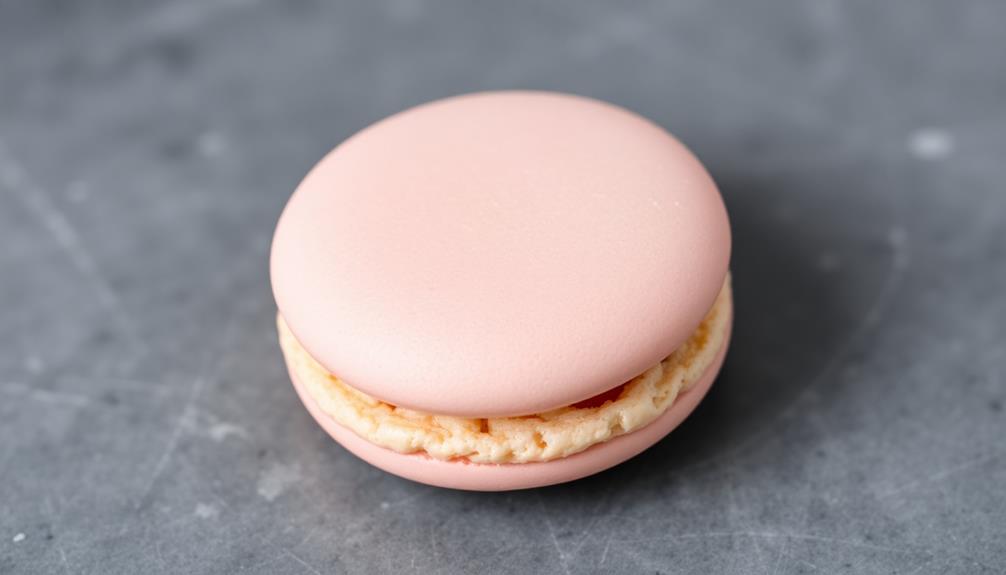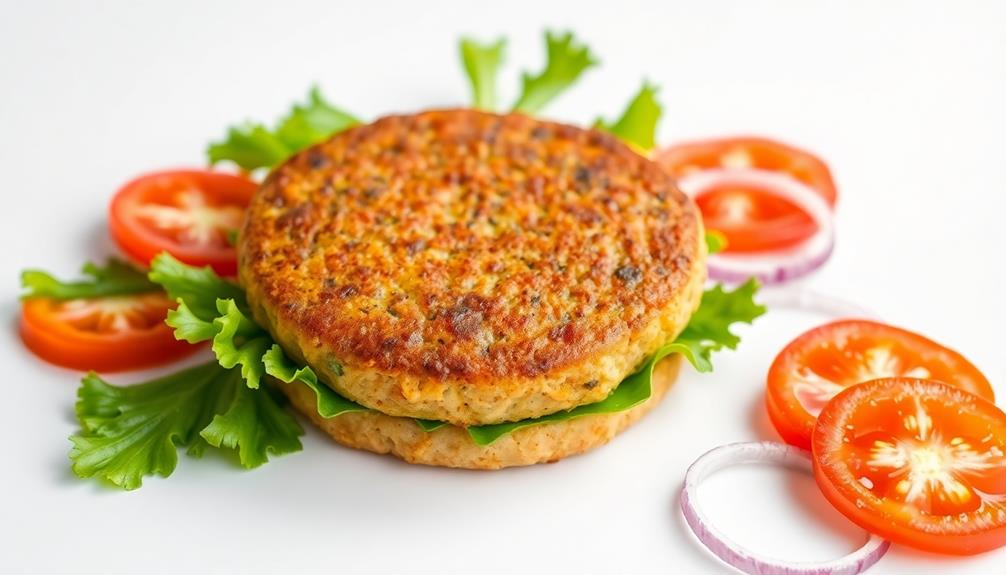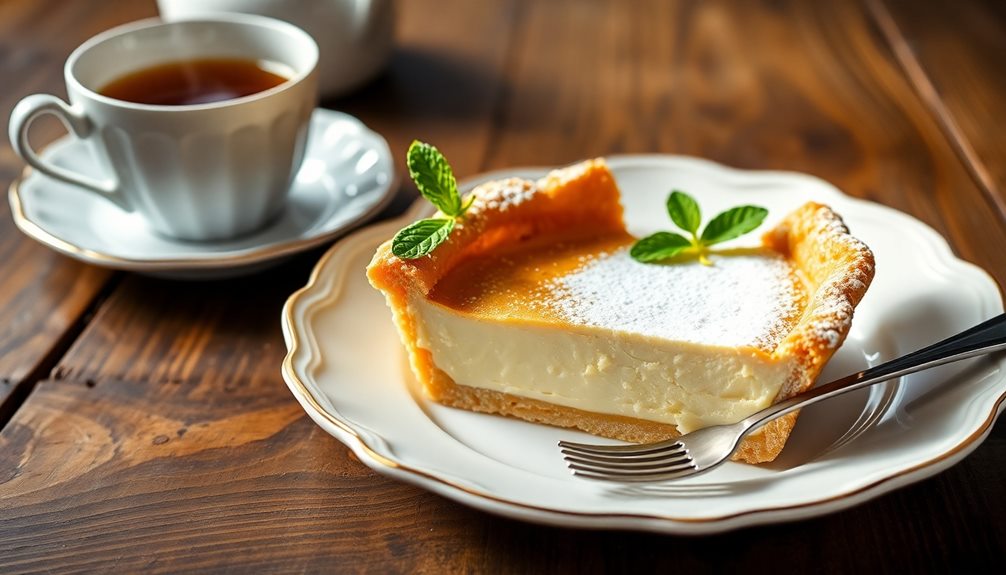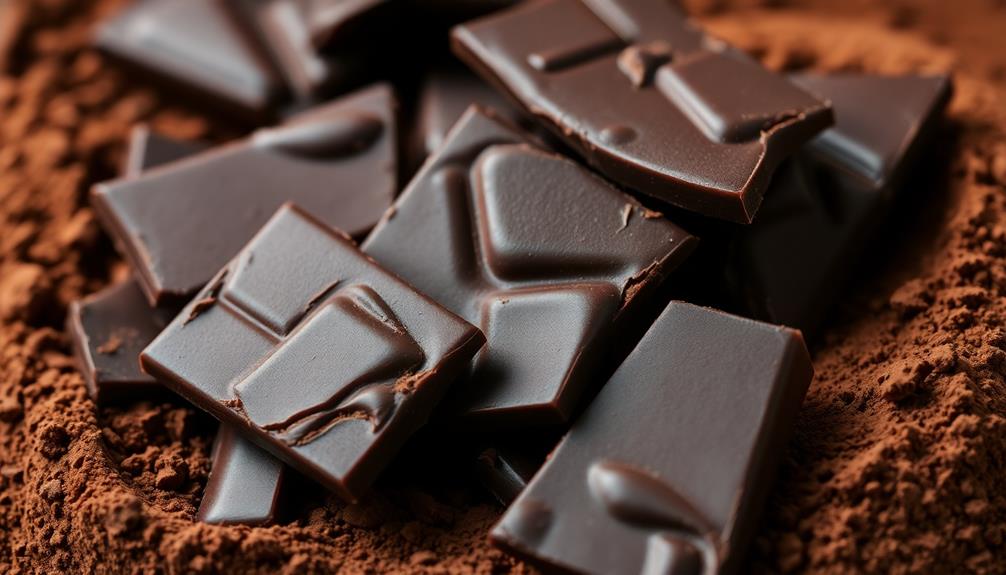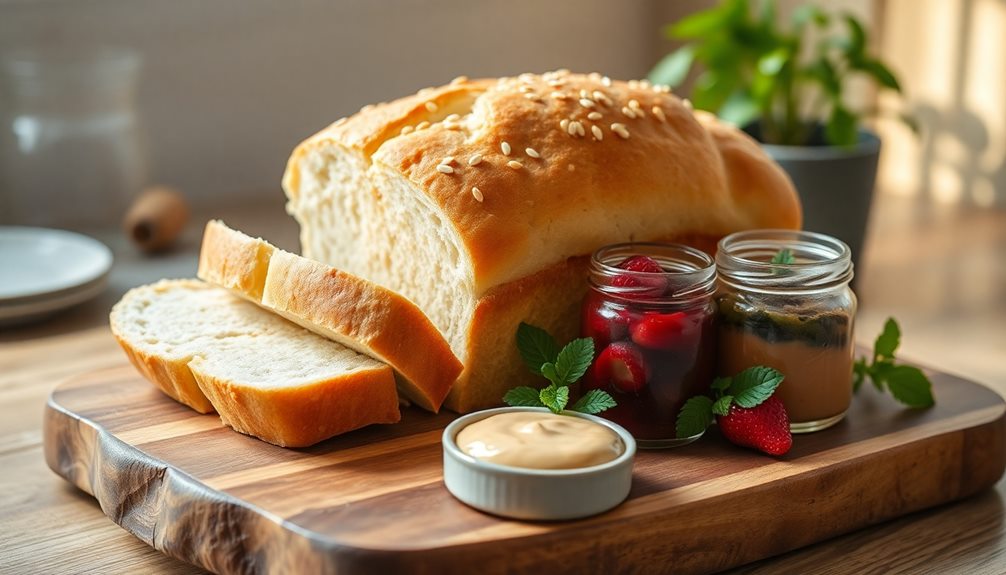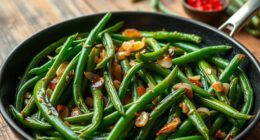French macarons – those light, airy cookies with crisp shells and chewy centers – started centuries ago with Venetian monks introducing them to France. Today, macarons are a beloved, quintessential French treat with endless flavor possibilities. To craft these delicate delights, you'll need just a few key ingredients: almond flour, powdered sugar, egg whites, and sugar. The secret is expertly folding the dry ingredients into whipped egg whites to maintain air pockets. Bake them to perfection, then let your creativity shine with fun fillings and dazzling colors. Mastering macarons is a delicious adventure – and you're about to discover why these captivating cookies have stolen the hearts of bakers everywhere.
Key Takeaways
Key points for "French Macarons: Mastering the Delicate Cookie":
- Macarons originated in France in the 8th century and have evolved into a beloved pastry with a wide range of flavors.
- Achieving the perfect macaron requires precise ingredient measurements, proper whipping of egg whites, and a delicate folding technique.
- Factors like oven temperature, baking time, and resting the piped batter are crucial for developing the desired crisp shell and chewy center.
- Patience, practice, and experimentation with flavors and designs are essential for mastering the art of making French macarons.
- Sharing the skills and techniques of macaron-making can create a community of enthusiasts and inspire continuous learning and creativity.
History
The origins of French macarons can be traced back to the 8th century, when Venetian monks first introduced the delicate almond-based confection to France.
These tiny, round cookies quickly became a beloved treat, with their crisp outer shells and soft, chewy centers. Over the centuries, the macaron evolved, with bakers experimenting with different flavors and techniques.
By the 1500s, Catherine de' Medici, the Italian-born queen of France, was known for her love of macarons. She even brought her own personal macaron chef with her when she married the French king.
This helped popularize the cookies throughout the French royal court.
Today, macarons are considered a quintessential French pastry, with bakeries across the country offering an array of vibrant, delectable flavors.
From classic vanilla and chocolate to more adventurous options like lavender and matcha, these delicate cookies continue to delight and captivate taste buds around the world.
Recipe
French macarons are delicate and delicious almond-based cookies that originate from France. These meringue-based confections are known for their smooth, lightly crisp exterior and soft, airy interior. Mastering the art of making French macarons can be a rewarding challenge, as it requires precise measurements and technique.
The key to successful macaron-making lies in correctly whipping the egg whites and folding them into the almond flour and confectioners' sugar mixture. This gentle folding process, known as "macaronage," is crucial for achieving the desired smooth, uniform batter that will result in perfectly baked macaron shells.
Ingredients:
- 100g almond flour
- 100g confectioners' sugar
- 80g egg whites (approximately 2-3 eggs)
- 25g granulated sugar
- Food coloring (optional)
Directions:
Preheat your oven to 300°F (150°C). Line a baking sheet with parchment paper or a silicone baking mat. In a food processor, blend the almond flour and confectioners' sugar until well combined. Sift the mixture to ensure a fine, even texture.
In a clean, dry bowl, whip the egg whites until they begin to foam. Gradually add the granulated sugar and continue whipping until stiff, glossy peaks form. Gently fold the almond flour mixture into the whipped egg whites, being careful not to overmix. If desired, fold in food coloring at this stage.
Pipe the batter onto the prepared baking sheet, creating small, evenly-sized discs. Allow the macarons to sit at room temperature for 30-60 minutes, or until a slight skin forms on the surface. Bake for 12-15 minutes, or until the macarons are lightly golden and easily release from the baking sheet.
When baking macarons, it's crucial to pay close attention to the oven temperature and baking time, as even slight variations can affect the final result. Additionally, proper preparation of the ingredients and precise execution of the folding technique are essential for achieving the desired smooth, uniform shells.
With a bit of practice and patience, you can master the art of making delectable French macarons in your own kitchen.
Cooking Steps
First, you'll need to sift the almond flour and powdered sugar together for a smooth texture.
Next, beat the egg whites until they're nice and fluffy.
Then, gently fold the dry ingredients into the egg whites – you don't want to overmix!
Step 1. Sift Almond Flour and Powdered Sugar

Sift the almond flour and powdered sugar together, ensuring a fine, lump-free consistency. This step is crucial for achieving the smooth, velvety texture that's so characteristic of French macarons.
Use a fine-mesh sieve and gently tap it against the counter to help the ingredients pass through. You'll want to sift them a few times to get the mixture just right.
Once you've sifted the dry ingredients, give them a quick whisk to combine them fully. This will help the batter come together more easily later on. You can do this step while your egg whites are whipping, so you're keeping things moving along efficiently.
Sifting may seem like a tedious task, but it's an important part of the macaron-making process.
Take your time and enjoy the satisfying feeling of watching the fine powder fall through the mesh. With a little patience, you'll have the perfect base for your delicate, delightful French macarons.
Step 2. Beat Egg Whites

Next, you'll want to whip the egg whites to stiff peaks. This is a crucial step in making delectable French macarons.
Grab your trusty stand mixer or hand mixer and get ready to work! Crack those fresh eggs and separate the whites from the yolks – you'll only need the whites for this part.
Turn on your mixer and let it work its magic, slowly increasing the speed. As the whites start to foam up, sprinkle in a bit of sugar, just a little at a time.
Keep whipping until the egg whites form stiff, glossy peaks. You'll know they're ready when you can turn the bowl upside down without the whites sliding out.
Be patient and let the mixer do its job – it may take a few minutes, but the results will be worth it!
With beautifully whipped egg whites, you're one step closer to making those light and airy French macarons everyone loves.
Step 3. Fold in Dry Ingredients Gently

With your whipped egg whites ready, it's time to gently fold in the dry ingredients.
You'll want to be extra careful here – you don't want to deflate all that lovely air you just whipped into those whites! Grab your sifted almond flour and powdered sugar, and slowly incorporate them into the egg whites.
Use a rubber spatula to gently cut and fold the dry mixture into the whites, making sure not to overmix. You'll see the batter start to come together, transforming from a fluffy cloud into a smooth, silky consistency.
Keep folding until the batter falls from the spatula in thick, ribbon-like strokes. This step is all about finesse – you want to maintain as much of that air as possible.
Once the dry ingredients are fully incorporated, your macaron batter is ready to pipe onto the baking sheets. Pipe with confidence, and get ready for perfect, delicate macarons!
Step 4. Pipe Batter Onto Parchment-Lined Baking Sheets

Grab your piping bag and firmly secure it with the large round piping tip.
Now, hold the piping bag straight up and gently squeeze the macaron batter into the tip. Slowly pipe the batter onto the parchment-lined baking sheets, making circular motions to create uniform, round shapes.
Don't worry if they're not perfect – the batter will spread a bit as it bakes.
Once you've piped all the batter, take a moment to admire your handiwork. See how the little macaron shells are perfectly formed, just waiting to be filled with delicious buttercream or jam?
Now, let's get them ready for the oven. Gently tap the baking sheets on the counter to release any air bubbles, then let the macaron shells rest for 30 minutes. This will help them develop their signature shiny, smooth tops.
When the timer goes off, pop those trays in the oven and get ready for the magic to happen! In just a few minutes, you'll have a tray of fluffy, light, and delectable French macarons.
Step 5. Bake at 300°F for 12-15 Minutes
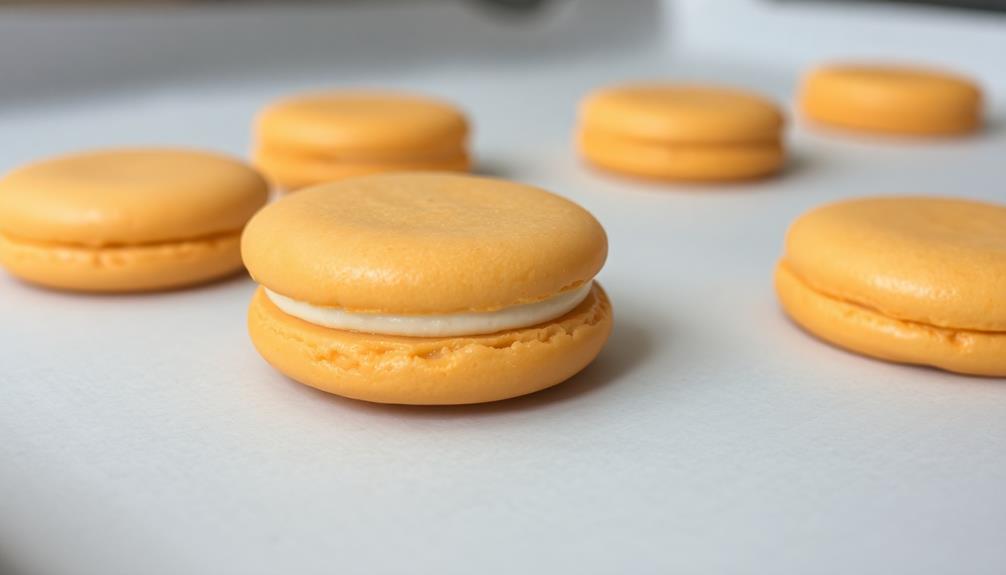
Your perfectly piped macaron shells are now ready for baking. Preheat your oven to a toasty 300°F. Carefully slide the baking sheets filled with your macaron shells into the oven.
As the oven door closes, you can almost hear the cookies start to sizzle and the delicious aroma wafting through the air.
Watch them closely as they bake for 12 to 15 minutes. The tops should develop a smooth, shiny "skin" and the feet, or frilly bottoms, should begin to form.
The timer will ding, signaling that it's time to check on your creations. Using oven mitts, gently remove the baking sheets from the oven. The macaron shells should be lightly golden and have risen nicely.
Let them cool completely on the baking sheets before carefully peeling them off the parchment paper. Now you're one step closer to enjoying those delicate, melt-in-your-mouth French macarons!
Final Thoughts
As you've now mastered the art of making delectable French macarons, it's time to reflect on your journey. Be proud of yourself! These delicate cookies may have seemed intimidating at first, but with patience and practice, you've conquered the tricky technique.
Imagine the delight on your family and friends' faces as you present them with your beautiful, vibrant macarons. The smooth, shiny shells and pillowy-soft centers will have them swooning. Not only do they taste heavenly, but the vibrant colors make them a true work of art.
Moving forward, don't be afraid to experiment with new flavors and designs. Play with different extracts, jams, and fillings to create your own signature macaron creations.
Share your skills by hosting a macaron-making party or giving baking lessons. Your newfound expertise will impress everyone who tries your homemade macarons. Savor this accomplishment – mastering French macarons is no small feat!
With your talent and determination, the macaron-making possibilities are endless.
Frequently Asked Questions
How Do I Store French Macarons Properly?
To store French macarons properly, keep them in an airtight container and refrigerate them. Allow them to come to room temperature before serving for the best texture and flavor. Avoid stacking or crowding the cookies.
What Are the Common Macaron Flavor Combinations?
There are countless delectable macaron flavor combinations you can experiment with. Classic options like chocolate, vanilla, and raspberry are always crowd-pleasers, but don't be afraid to get creative with unique flavors like earl grey, salted caramel, or even savory options.
Can I Make Macarons Without a Food Processor?
Yes, you can make macarons without a food processor. You can use a stand mixer or even a hand mixer to whip the egg whites and incorporate the dry ingredients. It may take a bit more effort, but it's certainly possible.
How Do I Troubleshoot Cracked Macaron Shells?
Cracked macaron shells can be caused by factors like over-mixing the batter, high oven temperature, or humidity. To troubleshoot, adjust your technique – mix the batter gently, lower the oven temp, and control the environment.
Are French Macarons the Same as American Macaroons?
No, French macarons and American macaroons aren't the same. Macarons are delicate French sandwich cookies made with almond flour, while macaroons are dense, coconut-based cookies. The two have completely different textures and flavors.
